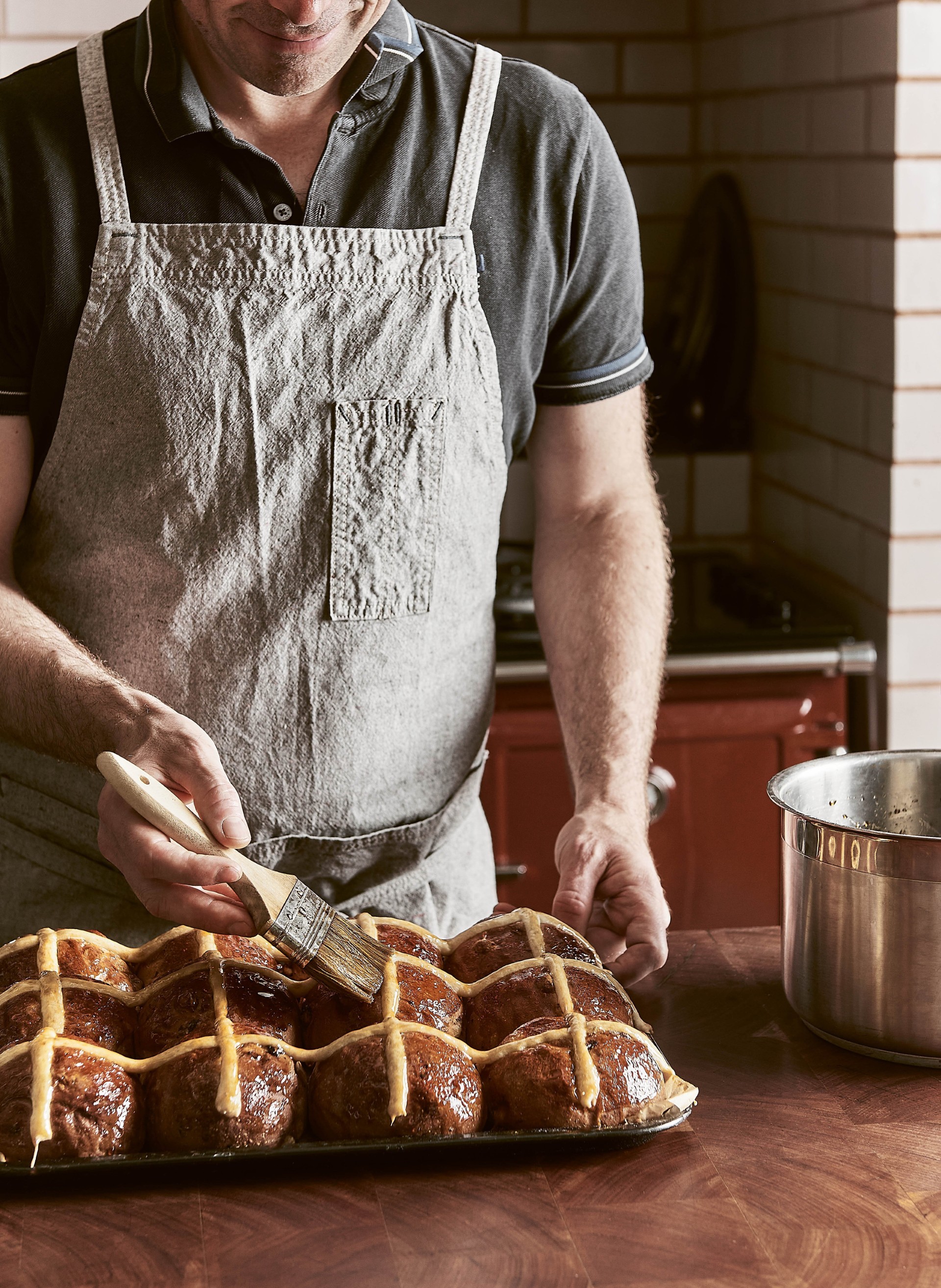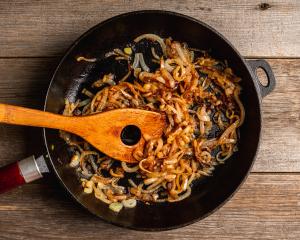

Late March into April is a beautiful time of year in Melbourne. The days are still warm, but the sting has gone out of the sun. And although hot cross buns were created for the northern spring, somehow they seem wholly more appropriate as an autumn bake.
Traditionally only baked with a cross on Good Friday, these days the frenzy for hot cross Easter buns starts to build straight after Christmas.
There are several factors in making a great bun, starting as always with the ingredients. Use the freshest spices you can for bold flavour, always grating the nutmeg yourself.

You’ll need to start a day ahead to soak the fruit; if it isn’t soaked, the fruit has a tendency to burn on the crust. If you want to make these over two days, just refrigerate the dough overnight after the first fold and finish off the buns the following day.
SEASONS ALTERED
You can find almost endless varieties of hot cross buns out in the wild, as bakeries try to appeal to the masses. We eschew a chocolate version, but have been known to switch out mixed peel for dried cranberries. Mixed peel can be divisive, and the cranberries provide a little sourness, which works really well.
THE BOOK
This is an extract from Sweet Seasons by Michael & Pippa James (Hardie Grant Books, RRP $NZ55). Photography: ©Rochelle Eagle
Easter buns
MAKES 12
Dough
260g full-cream (whole) milk
1 medium orange, unpeeled
500g baker's (strong) flour, plus 50g extra
40g soft brown sugar
10g fine sea salt
1 medium egg, at room temperature
20g fresh yeast or 10g dried yeast
50g unsalted butter, softened
80g currants, soaked in water overnight
80g sultanas, soaked in water overnight
80g raisins, soaked in water overnight
6g ground cinnamon
1g ground allspice
3g freshly grated nutmeg
1g ground clove
60g mixed peel
Brown sugar glaze
100g soft brown sugar
100g water
1 cinnamon stick
1 star anise
5 cloves
Cross mix
80g plain (all-purpose) flour
Pinch of fine sea salt
Pinch of caster (superfine) sugar
70g water
15g neutral-flavoured vegetable oil
Egg wash
1 egg
Splash of full-cream (whole) milk
Pinch of fine sea salt

Method
To make the brown sugar glaze, combine the sugar, water and spices in a small saucepan over a low heat. Bring it to the boil slowly, stirring constantly until the sugar has dissolved, then reduce the heat and simmer gently for about 5 minutes to infuse the spices. The mixture will reduce slightly, making a fragrant, sticky glaze. Pour the glaze into a container and store it at room temperature until required.
To start the bun dough, slowly bring the milk to a simmer in a saucepan over a medium heat, being careful not to let it boil. Remove from the heat and set aside to cool.
Place the orange in a saucepan and cover well with water. Bring to the boil, reduce the heat slightly and continue to boil for about 1 hour, until a knife goes through it easily. Drain, and when cool enough to handle, quarter the orange and remove any pips. Place it in a blender and blend for a minute or two, until you have a smooth puree, then set aside to cool.
Combine 500g of the flour with the sugar and salt in the bowl of a stand mixer fitted with the dough hook, and stir to combine. In a separate bowl, lightly whisk together the milk, egg and yeast, and add to the dry ingredients. Mix for 5 minutes on a medium speed, then stop the mixer and scrape down the side and base of the bowl with a spatula to ensure that all of the dry mix is incorporated and that the mixture is forming one large ball of dough. Mix for another 6 to 8 minutes until the dough is smooth and strong, and comes away easily from the side of the bowl.
With the mixer still running, incorporate the butter, a little at a time. Make sure it is being incorporated into the dough and not just coating the side of the bowl. You may need to stop and scrape down the sides once or twice. Mix for 2 to 3 minutes, until the dough is firm and shiny, not sticky or wet.
Use the windowpane test to check the dough. Take a small ball of dough and gently stretch it between your hands. You should be able to stretch it very thin without it breaking. If you find that it breaks easily, mix for a few more minutes to continue working the gluten in the flour, then test it again. If you are mixing by hand, this step will take a good 15 minutes of folding.
Once your dough has reached the right consistency, add 70g of the orange puree (you can freeze the rest for later use).
Drain the fruit and sprinkle the remaining 50g of flour over it and spices. Add the fruit and the mixed peel to the dough, then mix for 2 to 3 minutes, until the fruit is evenly dispersed. Be careful not to overmix, to avoid the fruit breaking down.
Turn the dough out on to a lightly floured bench and knead it for about 1 minute, then place it in a lightly greased bowl and fold it by lifting it up and over itself a few times, turning the bowl 90 degrees between each fold. Leave the dough to rest in the bowl, covered with a damp tea towel for 1 hour.
If you want to spread the workload over a couple of days, the dough will be fine left in the fridge overnight at this point.
Knead the dough in the bowl for about 1 minute, then fold the dough by lifting it up and over on to itself a few times, turning the bowl 90 degrees between each fold. Leave it to rest, covered with the damp tea towel for up to 1 hour, or until risen by half. Gently press the dough; it’s ready if your finger leaves a dent in the surface. If the dough springs back quickly, leave it longer, and then test again.
Turn the dough out on to a lightly floured bench and cut it into 12 equal pieces. Take each piece and gently flatten the dough, then bring the edges together in the middle so it forms a rough ball. Turn it over so the seam is at the bottom, then cup your hand over the dough and roll it on the bench using firm pressure until it forms a nice tight round ball with a smooth, even surface.
Line a baking tray with baking paper. Using firm pressure, roll each ball on the bench again. Putting pressure on the bun strengthens the dough; you want a round, firm ball that sits up on the bench rather than a saggy form.
Place the buns on the lined tray, evenly spaced out to allow for the eventual rise.
Cover with a damp tea towel and leave to rise for 1 and a-half to 2 hours, until risen by half. Test the buns again by gently pressing the surface if your finger leaves a dent, you’re ready to bake; if the dough springs back it still needs more time.
Preheat the oven to 200°C. To prepare the cross mix, combine all the ingredients in a bowl and whisk until a smooth paste forms. Put this into a piping (icing) bag with a plain nozzle and set aside.
Make the egg wash by lightly whisking the egg, milk and salt in a small mixing bowl, then brush it evenly over the buns. Pipe a cross on to each bun.
Put the tray in the oven, reduce the temperature to 180°C and bake for 10 minutes. Turn the tray and bake for a further 4 to 6 minutes, until golden brown.
While the buns are baking, warm the brown sugar glaze in a small saucepan. Once they are baked, lightly brush the surface of your buns with the syrup. Cool slightly on a wire rack, but not for too long.
They are best eaten when still warm, although they’re also excellent the next day, toasted and spread with lots of butter.













